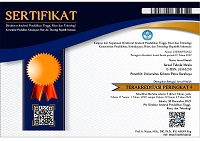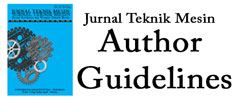Kekasaran dan Morfologi Hasil Pengelasan TIG Baja Tahan Karat 316 dengan Kadar Sulfur Berbeda
Keywords:
TIG welding, 316 stainless steel, sulfur, weld geometry, anode spot.Abstract
The presence of impurities in stainless steel can unexpectedly create a problem in welding. The difference of a small amount of impurities, from heat to heat, can induce the inconsistency in welding especially in automatic welding. This study is conducted to asses the influence of sulfur content of the steel on morphology of weld which is represented by the variation of weld pool and surface roughness of weld. The effect of sulfur on surface roughness of weld is studied in TIG welding of 316 stainless steels with different sulfur content. The influence of sulfur on the weld geometry, characterized by the ratio of depth and width of the weld (D/W), is studied in welding with various parameters. The variation of the weld geometry is conjointly studied in relation to the surface roughness of weldment. The effect of sulfur is also studied using a stationary arc with different current and duration. The variation of the diameter of a circular pool and the degree of protuberance which possibly emerged beneath the specimen is related to the sulfur content of the steel. The results of the study show the salient effect of sulfur on the surface roughness of weld. The surface roughness of steel with high sulfur content always more perturbed than that of steel with lower one; the different movement of liquid, characteristic of these two steels is posited to explain the difference. Greater degree of roughness is accompanied by a greater value of the ratio D/W. The results of the study with stationary arc show some points of a paramount importance. The effect of sulfur which hitherto considered advantageous to the formation of a weld with a higher ratio of D/W, turn out to be effective only in a specific range of welding parameters. In a different range, the weld geometry is more influenced by the arc characteristic, the anode spot. Abstract in Bahasa Indonesia: Keberadaan elemen impuritis dalam baja tahan karat seringkali tanpa diduga bisa menimbulkan masalah dalam pengelasan. Perbedaan dengan kadar yang sangat kecil elemen impuritis, seperti sulfur, dari sebuah heat ke heat yang lain, bisa menimbulkan kesulitan terutama pada pengelasan secara otomatis. Penelitian ini bertujuan untuk melihat pengaruh kadar sulfur baja terhadap pembentukan morfologi lasan yang ditunjukkan dengan perbedaan kekasaran permukaan dan pembentukan kolam lasan yang berbeda. Pengaruh kadar sulfur terhadap kekasaran permukaan kolam lasan dipelajari dengan mengadakan pengelasan Tungsten Inert Gas baja tahan karat 316 dengan kadar sulfur yang berbeda. Variasi morfologi kolam lasan, penetrasi (P) dan lebar (L) kolam lasan dan rasio P/L dikaitkan dengan kekasaran permukaan. Pengaruh sulfur dipelajari juga dengan peleburan dengan arus dan durasi penyalaan yang bervariasi. Pengaruh sulfur ditunjukkan dengan variasi diameter kolam lasan berbentuk lingkaran dan juga pada derajat tonjolan yang mencuat dari bawah spesimen. Hasil penelitian menunjukkan bahwa kekasaran permukaan baja sulfur tinggi selalu lebih besar dibanding baja sulfur rendah. Arah aliran cairan yang berbeda diajukan untuk menjelaskan fenomena ini. Kekasaran yang lebih besar ini diikuti dengan harga P/L yang lebih berarti. Pengamatan pada hasil peleburan dengan busur stasioner menghasilkan kesimpulan yang menarik. Pengaruh sulfur dalam menentukan morfologi kolam lasan lewat fenomena arah aliran cairan hanya berlaku pada rentang tertentu parameter penyalaan busur. Pada rentang yang lain, morfologi kolam lasan lebih banyak ditentukan oleh karakteristik busur, seperti anode spot, ketimbang arah aliran cairan. Kata kunci: Pengelasan TIG; baja tahan karat 316; sulfur; morfologi lasan; anode spot.Downloads
Published
2010-12-01
Issue
Section
Articles
License
Jurnal Teknik Mesin diterbitkan oleh Universitas Kristen Petra.
![]()
Artikel dan semua materi yang diterbitkan terkait didistribusikan di bawah Lisensi Internasional Creative Commons Attribution License (CC BY).


















